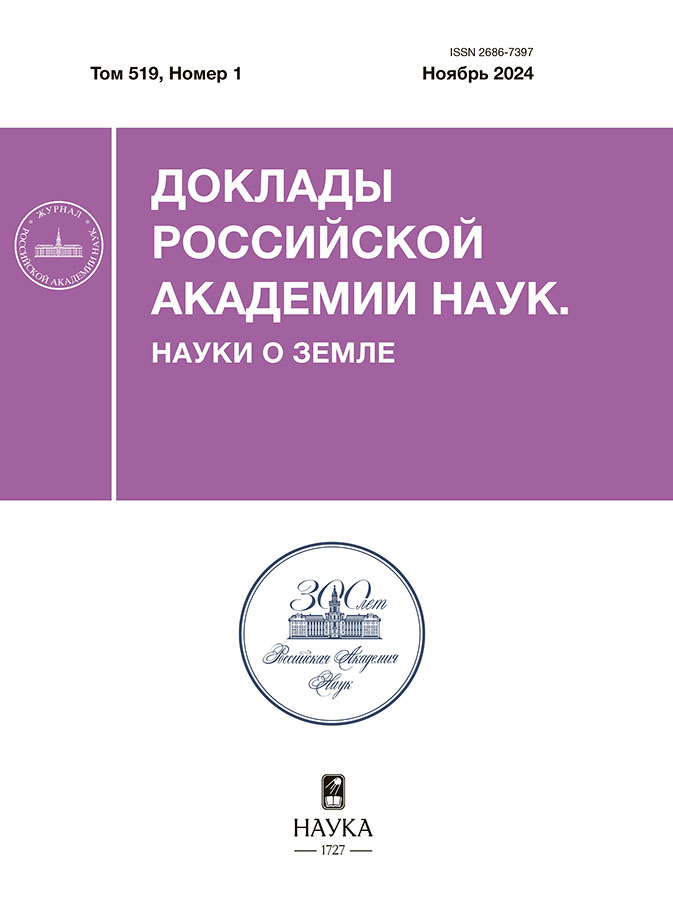Long-term changes in the activity of wave disturbances in the mesopause region
- Autores: Perminov V.I.1, Pertsev N.N.1, Semenov V.A.1, Dalin P.A.2,3, Sukhodoev V.A.1
-
Afiliações:
- A.M. Obukhov Institute of Atmospheric Physics, Russian Academy of Sciences
- Swedish Institute of Space Physics
- Space Research Institute, Russian Academy of Sciences
- Edição: Volume 519, Nº 1 (2024)
- Páginas: 543-549
- Seção: CLIMATIC PROCESSES
- ##submission.dateSubmitted##: 04.06.2025
- ##submission.datePublished##: 20.12.2024
- URL: https://cijournal.ru/2686-7397/article/view/682440
- DOI: https://doi.org/10.31857/S2686739724110186
- ID: 682440
Citar
Texto integral
Resumo
According to temperature variations obtained on the basis of spectral observations of hydroxyl airglow at the Zvenigorod scientific station of A.M. Obukhov Institute of Atmospheric Physics RAS during 2000−2024, as well as on the basis of statistical analysis methods, long-term trends and dependences on solar activity were obtained for wave disturbances at mesopause altitudes (80−100 km). Using digital frequency filtering, their activities were determined in three regions of wave periods 0.7−2.0, 1.4−4.1 and 2.7−8.2 hours with maxima at 1, 2 and 4 hours. The root-mean-square values of temperature half-differences served as an indicator of wave activity. Both year-round and average seasonal (winter, summer) values were analyzed. As a result, it was established that wave activity has positive trends with their dependence on the frequency band of disturbances (in winter the trend is greater in the high-frequency band, in summer the trend is greater in the low-frequency band). The dependence on solar activity is positive. Its values are greater for the high-frequency band of disturbances, as well as in winter.
Palavras-chave
Texto integral
Sobre autores
V. Perminov
A.M. Obukhov Institute of Atmospheric Physics, Russian Academy of Sciences
Autor responsável pela correspondência
Email: v.perminov@rambler.ru
Rússia, Moscow
N. Pertsev
A.M. Obukhov Institute of Atmospheric Physics, Russian Academy of Sciences
Email: v.perminov@rambler.ru
Rússia, Moscow
V. Semenov
A.M. Obukhov Institute of Atmospheric Physics, Russian Academy of Sciences
Email: v.perminov@rambler.ru
academician of the RAS
Rússia, MoscowP. Dalin
Swedish Institute of Space Physics; Space Research Institute, Russian Academy of Sciences
Email: v.perminov@rambler.ru
Suécia, Kiruna; Moscow, Russian Federation
V. Sukhodoev
A.M. Obukhov Institute of Atmospheric Physics, Russian Academy of Sciences
Email: v.perminov@rambler.ru
Rússia, Moscow
Bibliografia
- Семенов А.И., Шефов Н.Н., Фишкова Л.М., Лысенко Е.В., Перов С.П., Гивишвили Г.В., Лещенко Л.Н., Сергеенко Н.П. Об изменении климата верхней и средней атмосферы // Доклады АН СССР. 1996. Т. ٣٤٩. № ١. С. ١٠٨−١١٠.
- Golitsyn G.S., Semenov A.I., Shefov N.N., Fishkova L.M., Lysnko E.V., Perov S.P. Long-term temperature trends in atmosphere // Geophys. Res. Let. 1996. V. 23. № 14. P. 1741−1744.
- Zhao X.R., Sheng Z., Shi H.Q., Weng L.B., He Y. Middle atmosphere temperature changes derived from SABER observations during 2002–20 // J. Clim. 2021. V. 34. P. 7995−8012.
- Bailey S.M, Thurairajah B., Hervig M.E., Siskind D.E., Russell III J.M., Gordley L.L. Trends in the polar summer mesosphere temperature and pressure altitude from satellite observations // J. Atmos. Sol.-Terr. Phys. 2021. V. 220. 105650.
- Перминов В.И., Перцев Н.Н., Далин П.А., Семенов В.А., Суходоев В.А., Железнов Ю.А., Орехов М.Д. Многолетний тренд температуры в области мезопаузы по наблюдениям гидроксильного излучения в Звенигороде // Геомагнетизм и аэрономия. ٢٠٢٤. Т. ٦٤. № ١. С. ١٠١–١١٢.
- French W.J.R., Mulligan F.J., Klekociuk A.R. Analysis of 24 years of mesopause region OH rotational temperature observations at Davis, Antarctica – Part 1: long-term trends // Atmos. Chem. Phys. 2020. V. 20. P. 6379–6394.
- Kalicinsky C., Kirchhoff S., Knieling P., Zlotos L.O. Long-term variations in the mesopause region derived from OH*(3,1) rotational temperature observations at Wuppertal, Germany, from 1988−2022 // Adv. Space Res. 2024. V. 73. № 7. P. 3398−3407.
- Baker D.J., Stair A.T. Rocket measurements of the altitude distributions of the hydroxyl airglow // Physica Scripta. 1988. № 37. P. 611−622.
- Garcia R.R., Yue J., Russell J.M. Middle atmosphere temperature trends in the twentieth and twenty‐first centuries simulated with the Whole Atmosphere Community Climate Model (WACCM) // J. Geophys. Res. − Space Physics. 2019. V. 124. P. 7984–7993.
- Qian L., Burns A.G., Solomon S.C., Wang W. Carbon dioxide trends in the mesosphere and lower thermosphere // J. Geophys. Res. − Space Phys. 2017. V. 122. P. 4474–4488.
- Solomon S.C., Liu H.-L., Marsh D.R., McInerney J.M., Qian L., Vit F.M. Whole atmosphere simulation of anthropogenic climate change // Geophys. Res. Lett. 2018. V. 45. P. 1567–1576.
- Andrews D.G., Holton J.R., Leovy C.B. Middle Atmosphere Dynamics. San Diego: Academic Press, 1987. 489 p.
- Перминов В.И., Семенов А.И., Шефов Н.Н. О вращательной температуре гидроксильной эмиссии // Геомагнетизм и аэрономия. ٢٠٠٧. Т. ٤٧. № ٦. С. ٧٩٨–805.
- Pertsev N., Perminov V. Response of the mesopause airglow to solar activity inferred from measurements at Zvenigorod, Russia // Ann. Geophysicae. 2008. V. 26. № 5. P. 1049−1056.
- Gavrilov N.M., Popov A.A., Dalin P., Perminov V.I., Pertsev N.N., Medvedeva I.V., Ammosov P.P., Gavrilyeva G.A., Koltovskoi I.I. Multiyear variations of time-correlated mesoscale OH temperature perturbations near the mesopause at Maymaga, Tory and Zvenigorod // Adv. Space Res. 2024. V. 73. No. 7. P. 3408−3422.
- Перминов В.И., Семенов А.И., Медведева И.В., Перцев Н.Н. Изменчивость температуры в области мезопаузы по наблюдениям гидроксильного излучения на средних широтах // Геомагнетизм и аэрономия. ٢٠١٤. Т. ٥٤. № ٢. С. ٢٤٦−٢٥٦.
- Gossard E.E., Hook W.H. Waves in the atmosphere. New York: Elsevier Scientific Pub. Co. 1975. 456 p.
- Jacobi Ch. Long-term trends and decadal variability of upper mesosphere/lower thermosphere gravity waves at midlatitudes // J. Atmos. Sol.-Terr. Phys. 2014. V. 118. P. 90−95.
- Yigit E., Medvedev A.S. Heating and cooling of the thermosphere by internal gravity waves // Geophys. Res. Lett. 2009. V. 36. L14807. https://doi.org/10.1029/2009GL038507
- Hickey M.P., Walterscheid R.L., Schubert G. Gravity wave heating and cooling of the thermosphere: sensible heat flux and viscous flux of kinetic energy // J. Gephys. Res. 2011. V. 116. A12326. https://doi.org/10.1029/2011JA016792
- Gavrilov N.M., Kshevetskii S.P., Koval A.V. Thermal effects of nonlinear acoustic-gravity waves propagating at thermospheric temperatures matching high and low solar activity // J. Atmos. Sol.-Terr. Phys. 2020. V. 208. 105381.
Arquivos suplementares











